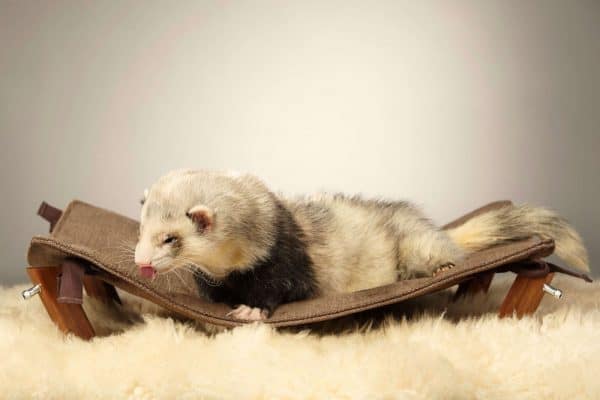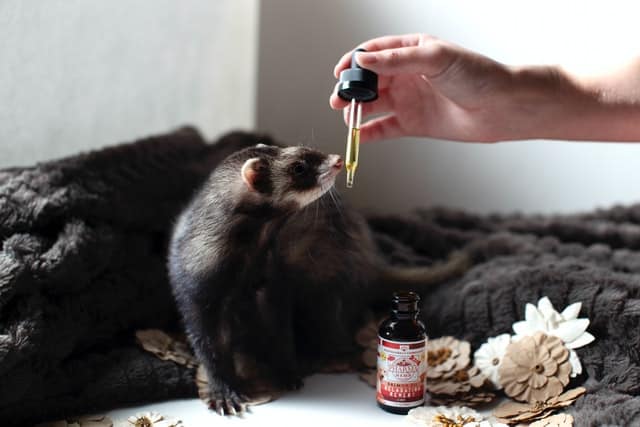Ferrets don’t occur naturally anywhere in the world. All ferrets come from breeders, be it your pet ferret or hunting companion ferret. And those breeders definitely don’t have an easy job with these creatures. It’s an expensive and exhausting process for everyone involved.
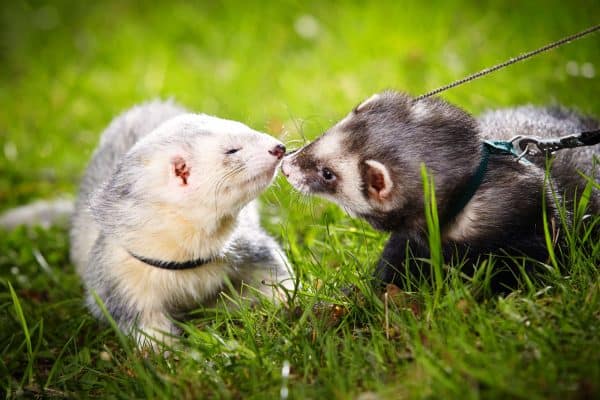
Jills can come into heat once or twice a year and with proper lighting tricks, a breeder can cause the ferret to go into heat up to 5 times a year. And every time a jill is in heat, she has to find a mate or risk getting sick and even dying. This is why pet ferrets are always neutered.
In this article, we’ll talk about everything a beginner ferret breeder needs to know.
What time of year do ferrets have babies?
Ferrets are known to go into heat when they notice the days getting longer and warmer. This usually happens in spring and summer, but it can also happen in fall. And since they depend on the available light to go into heat, a breeder can create the perfect circumstances to help get the ferrets in heat up to 5 times a year.
This means you can end up with lots of kits any time of the year. But the rule of the thumb is usually spring and summer. And by the next spring, jills are ready to mate. For hobs, it takes a little bit longer, sometimes twice as long.
The rest of the year ferrets won’t breed so it’s important to pay attention to the signs and use the opened window to mate them if you’re a breeder. If you don’t have any experience breeding ferrets, you will be a little bit shocked the first time it happens but it’s manageable.
Regardless of the time of the year your ferret makes babies, you need to make sure she gets all the nutrients she needs during and after the pregnancy. A healthy and well-fed jill will be able to feed a bigger litter without any issues.
If by any chance you can’t provide everything a pregnant jill and a new ferret mommy needs during a specific time of the year, avoid breeding your ferrets around that time. But when it happens, make sure you have all the time necessary for them.
You should be ready for them to get into season between March and September. Tricking them into going into season more than twice a year is difficult and should be left to experienced breeders or until you’re getting 100% sure of what you’re doing.
How to tell when the Jill is in heat
You can very easily tell when a ferret is in heat. Both males (referred to as hobs) and females (referred to as jills) develop a very pungent smell. They start stinking so bad that you’ll need to move them to a separate room with proper ventilation.
More than that ferrets will start producing a lot more oils and their skin will get extremely greasy. They’re definitely not the adorable and fluffy creatures that you could always pet anymore. They get more and more disgusting and you’ll want to keep the contact to a minimum.
Jills in heat will a very noticeable vulva that starts to enlarge and get more and more swollen. It’s impossible to ignore or miss. It will start slowly getting bigger and bigger until she’s ready to mate, which usually happens in about 14 days.
More than that, jills also start leaking a pink and watery secretion from their vaginal areas. This whole mess makes the mating season a living hell for jills that don’t have access to a male. They will remain in this state until they either mate or the breeding period is over, which can last a very long time.
How do you get a ferret out of season?
A jill in heat that doesn’t mate can die of aplastic anemia without any medical intervention. The moment you take her to a vet you will be highly advised to spay her, which is a safe procedure and will save the jill’s life without any complications.
If spaying is not an option for you but you can’t provide a male ferret for your jill in heat you should still go to the vet. This is because there are still two ways possible to get a jill out of season. You can introduce her to a vasectomized male or use a jill jab injection.
When a jill in heat is introduced to a vasectomized male, he will start “mating” with her but won’t be capable of producing offspring. This might create a phantom pregnancy until the season is over or she starts getting into heat again and you have a male for her.
A vasectomized hob has pretty much the same characteristics as any other ferret in rut. It comes in season at the same time and it will develop the same musky odor. It might also be just as aggressive to other male ferrets and will have to be separated.
The same thing can also be done with the help of a jill jab injection. It contains devosterone that is capable of tricking her body into thinking it’s pregnant. The advantage is that it lasts a lot longer, between 4 and 6 months, while the disadvantage is that they will start gaining weight and lose their “work-ethic”.
Placing the Ferrets Together – Making the Pregnancy Happen
When the jill is ready to mate, it’s recommended to take it to the hob’s territory. And no matter how disturbing and violent the mating process seems to you, do not attempt to separate them until the end. And this can last hours and hours, and it’s even recommended to leave them together for a whole day to ensure pregnancy.
They will both take breaks to drink water, eat, and clean themselves, then start again. The male has a curved penis and you can do a lot of damage if you try to separate them once the hob “locks” with the female. You can go away and leave them alone until it’s done, but be home and ready for anything.
The reason why you might get spooked for the first time is that the mating ritual of ferrets is definitely not a pleasant one. Jills are induced ovulators that need to be stimulated to begin egg production. And this is done by the hob while biting the neck of the jill, which releases hormones into her body that triggers the ovulation.
Unfortunately, it’s not a simple few bites the jill will go through. You will quickly notice that the hob will start biting the neck more and more violently and will even drag the jill around the cage. The jill will allow herself to be dragged around if she is ready to mate, if not, she will try to fight back and you need to intervene.
After the whole process is done, you need to take the jill back to its cage and check her for serious neck punctures and bleeding. She may or may not need a vet visit to patch her up. You will be able to tell if she’s pregnant in two weeks, or you’ll have to start again.
A jill will remain in heat until she is bred and this can lead to various health issues if you’re ignoring her. She might end up with pyometra, bladder infection, and anemia. Most jills die within a year if they’re not bred or they don’t get any medical help.
A Jill’s Pregnancy – What Happens
First of all, you need to be aware that phantom pregnancies are very common. The jill will start acting exactly the same as if she were pregnant and you won’t be able to tell for quite some time. High levels of hormone can cause some females to bloat as well.
It’s recommended to be ready to invest in a vet visit that includes an ultrasound. This is the safest way to know if your jill is truly pregnant or not. Unfortunately, this can be pretty expensive. But since the whole process will take you to the vet multiple times, don’t even attempt ferret breeding if you don’t have the money.
Pregnant jills will start to eat more, get fatter, and may even make clucking noises. She will also start pulling hair out of her tail and body for nesting. Be careful when you’re handling her as she might consider your hair great for nesting as well.
The jills’ pregnancy can last between 40 to 42 days and you need to be available most of the time. Both the pregnancy and the birth process can leave her with serious health issues, even death. You will immediately need to start feeding her high-end quality ferret food.
A pregnant jill that doesn’t get all the nutrients she needs, especially when she’s about to give birth, can develop toxemia. This means you need to immediately take her to the vet, which will perform a cesarean section to help save the lives of both your jill and her kits (ferret babies).
During pregnancy, there’s no need to separate the hob from the jill, unless you notice serious problems between them. The hob can help take care of the jill during the pregnancy. However, when the jill is about two weeks away from giving birth, she will need her privacy.
You’ll need to place the cage in a warm and very quiet side of your home. The bedding should be made of soft and fluffy paper so she can properly prepare herself for giving birth. The food and water intake will also have to be increased.
After the jill gives birth, leave her and the babies alone for a week. This doesn’t mean you’ll have to throw food and water from a distance. You’ll just have to maintain minimum contact and be very fast. You don’t want to spook the new mommy. More on caring for ferret babies in this article.
Ferret Pregnancies and Vet Visits
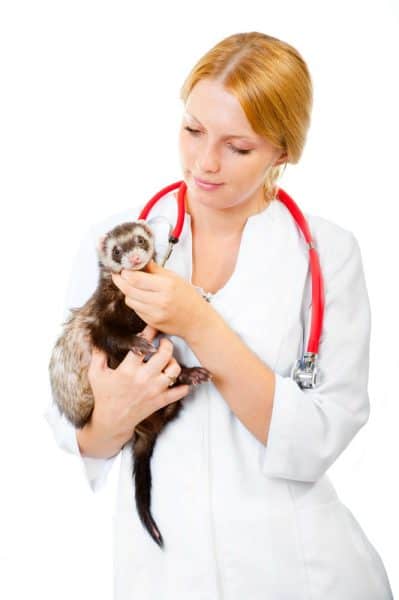
The vet visits start the moment you decide to breed the two ferrets. The first visit will be all about their health and if the jill can carry out a pregnancy with as few risks as possible. This is very important and you should absolutely never skip this vet visit.
You should keep in mind that it’s best to take your ferrets to a vet that is an expert in ferrets. A simple cat and dog vet might not be enough in case of an emergency. And you will need to keep that vet on speed dial for the next few weeks.
Another thing the vet will check for is if the ferrets are related. This means DNA tests that will confirm 100% that they’re not siblings, cousins, parent and offspring, etc. If they are, they should never be bred. Otherwise, the kits will be so deformed that they might need to be put down.
When you think your jill is pregnant or should be pregnant, take her to the vet again. The vet will confirm her pregnancy with an ultrasound procedure or let you know it’s a phantom pregnancy. If she is, the vet should check how she’s handling it and if everything is ok.
You should keep going back to the vet if you notice any distress from your jill. This includes sounds of pain, biting, acting violently, stopping to eat and/or drink, etc. Ferrets will try their best to communicate with you and tell you something is wrong.
The vet will also provide supplements or injections that can make up for the lacking vitamins or anything she should be getting from food but isn’t. Ferret breeding comes with lots of complications and unpleasant situations, which means you should never ignore even the faintest sign of trouble.
A simple vet visit can show that the jill has pregnancy toxemia and needs immediate medical intervention. Without a cesarean section, she and her babies might not make it. And if she gives birth at home, make sure she didn’t develop mastitis, which is a mammary gland infection. The vet on the phone can help you out.
You should also take the jill to the vet a few weeks after the birth, along with the kits to make sure she’ll have a fast and healthy recovery. The vet will also check the kits for ear mites, parasites, fleas, and any birth defects.
Any kit should receive the canine distemper vaccine at 2 and 4 months old. And when they’re 3 and 4 months old they need the rabies vaccine.
Ferret Pregnancy Diets – What to Feed Them (Food, Water, Vitamins)
Pregnant jills will need the best food you can find and ask your vet for recommendations on what you can replace with what. They need an increased protein and calorie intake that can match their energy expulsion. Always consult your vet when you decide to change their food mid-pregnancy.
You should always provide clean and fresh water as a pregnant jill will start drinking up to 3 times more water than she would normally. Avoid using a cage bottle as it becomes too much of a hassle for the jill. Instead, opt for a dish as she will drink more this way.
Two weeks before birth, you will have to increase her food intake again, along with the water. When feeding the jill after giving birth be very stealthy and keep contact to a minimum if possible. She’ll need to be fed the same as before giving birth.
A nursing jill needs the increased intake of energy, especially with a larger litter. Sometimes, if the litter is larger than 10 kits, she might not even gain any weight no matter how much she eats. This is because her energy and calorie demands outweigh how much she can eat.
Taking Care of a New Mother and Baby Ferrets
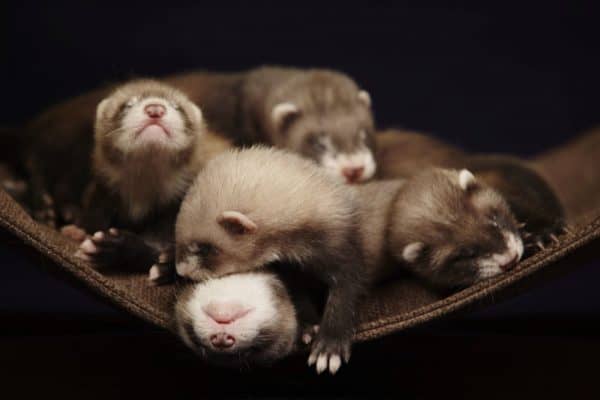
One thing you should always keep in mind is to absolutely never scare the jill after giving birth and stay as far as possible for at least a week. This is because a scared or threatened jill will eat her kits. It’s very common and you need to be very careful during the first week, and even the second.
Always feed her on time and never leave her without water. While she is busy eating, you can throw a look over the babies, check how many there are, and if any of them are dead. Regardless of how much you feed your jill, if the litter is bigger than 10, she may lose weight or just simply not gain any.
Another thing to keep in mind is that newborn ferrets smell horrible. You’ll need to keep the new mom and her babies in a very well-ventilated area. Otherwise, the cage will quickly become unbearably smelly along with the room it’s in.
You should keep the bedding changes to a bare minimum and only do it to check for neglected kits. The kits are born hairless and with their eyes and ears sealed shut. And when they grow a little bit, they tend to wander around the cage and not be able to come back since they’re still blind and deaf. The kits are 100% dependent on their mom.
The mum may let you handle the kits after one week and immediately let you know when it’s time to give them back. She will often enjoy your company after a few weeks and even try to bring you to her litter, but still not allow you to touch them. It’s a “you can look but you can’t touch” arrangement.
It’s recommended to handle the kits from a few seconds to a few minutes a day so they get used to you and humans in general. Small kits can be simply kept in the palm of your hand, while bigger ferrets can be picked up by their scruff with one hand and held by their legs for support with the other.
When it comes to feeding the kits, you should leave it to the mother only for the first three weeks. Then you can start feeding them baby food and a few shredded pieces of raw meat. You can even opt for kitten kibble that’s slightly soaked in water or kitten milk.
The food for the kits should be high in protein and low in carbohydrates, and obviously, meat-based. And at 6 weeks old, they can be weaned and get used to less and less soaked ferret kibble. Then after a few more weeks, they can be fed as an adult ferret.
Ferrets are highly dependant on their mother and you should never separate them until they’re at least 12 weeks old, 10 if you don’t have any other choice. There are breeders that sell them as early as 6 weeks after birth, which can lead to extremely frightened and jumpy adult ferrets.
The kits will have a full set of adult teeth when they’re 9 months old. It’s important they grow healthy and happy so you can enjoy friendly and cuddly ferret adults.
If you have any concerns, keep your vet on speed dial, and don’t think twice before calling. As mentioned before, ferret breeding is not easy and definitely not affordable. It’s not very common for ferret breeders to make a good profit from ferret breeding. And the money you make you’ll probably spend on therapy to deal with all the stress and disturbance the job can cause.
FAQ – Frequently Asked Questions
Is ferret breeding easy?
Ferret breeding is definitely not easy and definitely not pleasant. They require a lot of attention and lots of things could go very wrong, very fast.
Is ferret breeding profitable?
Ferret breeding requires constant visits to the vet for both ferrets and then the kits. Then the kits need vaccines and neutering. This makes ferret breeding rarely profitable.
What time of year do ferrets make babies?
Generally, ferrets make babies in spring and summer, when the days are longer and warmer.
What are the signs of a ferret in heat?
You can tell a ferret is in heat when it starts developing a pungent smell and very greasy skin. The jill gets a swollen and enlarged vulva while the hob has swollen testicles that drop.
At what age do ferrets go into heat?
Jills go into heat at 4 months old while hobs can get into rut, for the first time, when they’re between 6 to 8 months.
Will a jill in heat die if she’s not bred?
A jill in heat can develop anemia, pyometra, and bladder infections and die if there’s no medical intervention.
How do you get a ferret out of season?
You can get a jill out of season by simply spaying her. You can also use a jill jab injection that contains proligestone or introduce her to a vasectomized hob. Both options get the jill out of heat without impregnating her.
How many kits can a ferret have in one litter?
A jill can give birth to anywhere between 1 and 15 kits.

